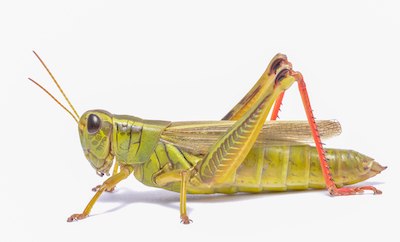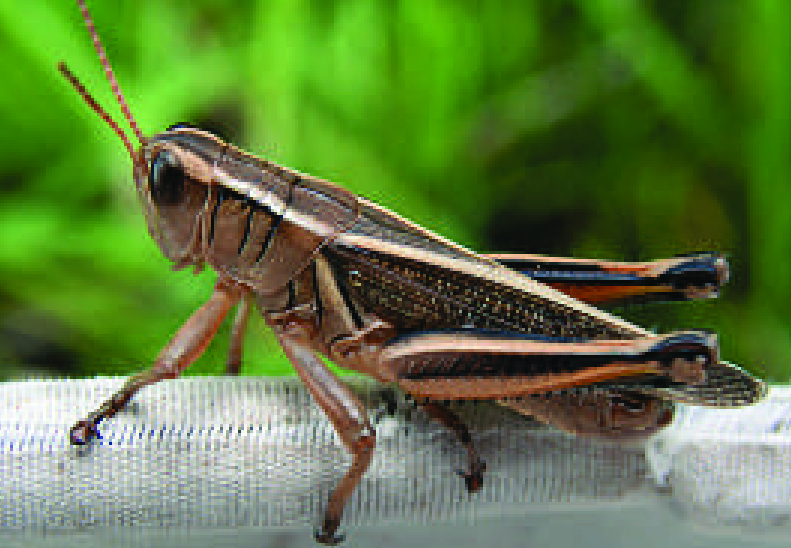Friend or Foe?
Grasshopper: Munching Pest or Controlling Invasives?
By Ann M. Mason, Fairfax Master Gardener Intern

Red-legged grasshopper
Let’s look at the physical and behavioral characteristics that set crickets and grasshoppers apart and make identification of these insect cousins easier. Grasshoppers are diurnal and active during the day, while crickets are nocturnal, active at night. Generally, grasshoppers are larger than crickets. They are lighter in color than crickets and are neutral green, grey or light brown. Crickets have bright or dark colors. Both grasshoppers and crickets can jump, and grasshoppers can also fly.
Antennae size and shape are very different for grasshoppers and crickets. Grasshoppers have short, horn-like antennae, while crickets boast longer, slender ones — longer than their body length. Grasshoppers eat plants (herbivorous); crickets are predators and eat plants and other insects (omnivorous). Both male and female grasshoppers produce chirping sounds by rubbing their hind legs with their wings; only male crickets make a chirping sound by rubbing the top of one wing across the teeth at the bottom of the other wing.

Melanoplus differentialis
So, what do grasshoppers feed upon? We are all familiar with these voracious insects munching away on some of our crops including lettuce, potato, beans and corn. But we may not give Gregory Grasshopper and his friends credit for keeping invasive grasses in check. Yep, scientists at the University of Maryland who study grasshoppers have found that these critters preferentially chomp down on some of the introduced plants that invade our gardens, greenspaces and National parks. For example, our ‘friends’ in the grasshopper species Melanoplus happily prefer timothy grass (Phleum pratense), Chinese silvergrass (Miscanthus sinensis) and Johnsongrass (Sorghum halepense) — some of the grasses on Virginia’s invasive plant list. With this food preference, these Melanoplus grasshoppers are part of the biologic ‘army’ that challenges the spread of these invasive grasses.

Two-striped grasshopper
Grasshoppers do not have a pupal stage like a butterfly. From the time the grasshopper nymph emerged from the soil to its adult form, it always looked like a grasshopper. As it grows it actively feeds first on young clover and grasses and then on to the grasses’ tougher leaves and stems. The adults are killed by cold temperatures. Fall debris removal and turning over the soil in possible grasshopper nurseries can expose the eggs to predators and to cold temperatures.
You might think that nature has too many grasshoppers. But in the balance of nature, grasshoppers are tasty morsels for crows, catbirds, bluebirds, mockingbirds and sparrows. Some spiders are known to find them tasty. The female flesh fly (Sarcophaga kellyi) does an aerobatic move to place her eggs on a grasshopper. The eggs immediately become larval maggots using the unsuspecting grasshopper as its food. In the soil the females of the blister beetles (Epicauta vittata and E. marginata) lay their eggs near those of the grasshopper. The larvae of these beetles ravish the grasshopper eggs.
Grasshoppers are in the sights of some fly species and wasp-like insects. However, if these biological controls are insufficient for keeping grasshoppers in check in your garden, the VA Tech experts recommend that gardens not be planted next to hay fields and ditches high in grasshopper populations. Protect your seedlings by covering them with cheesecloth or other small mesh netting.
If your garden is infested and the biological controls are overwhelmed, VA Tech recommends that the homeowner use either organic controls or chemical controls of a registered insecticide applied following the labelled instructions. Application of either organic or man-made insecticides requires precautions and pre-harvest waiting periods.
Many cultures have recipes for preparing grasshoppers, de-legged, de-headed and de-gutted, into tasty protein meals. The United Nations Food and Agriculture Organization (FAO) advocates that people should raise insects, including grasshoppers, as food. And I have heard from my grandson that properly prepared grasshoppers (purchased in a package in his case) are a unique but welcome snack at Scout campouts. Yum, Yum.
Resources
• Grasshoppers, Eric Day and Alexandra Spring, Virginia Tech Publication 3104-1550
• Difference Between Crickets and Grasshoppers, S. Prabhat
• Grasshoppers: Life Cycle and Control, Stanton Gill, University of Maryland
• Protect or Destroy? The Role of Native Grasshoppers in their Home Habitats, Dylan Kutz and Serhat
Solmaz, University of Maryland
• Should I Eat or Should I Go? Acridid Grasshoppers and Their Novel Host Plants, Potential for Biotic
Resistance, Alina Avanesyan, University of Maryland
• Destination Corkscrew Swamp Sanctuary, Florida: Mighty Defenses of the Eastern Lubber Grasshopper,
Romalea Microptera, Michael Raupp, Bug of the Week
• Investigate a Grasshopper’s Life Cycle in Your Schoolyard, (grade K-2, ES-1 Science, Math), VA
Governor’s Conservation Classroom Challenge
• Insects: Their ways and means of living, Robert Evans Snodgrass, Smithsonian Institution
• Edible Insects, Future prospects for food and feed security, Food and Agricultural Organization of the
United Nations, FAO Report 171